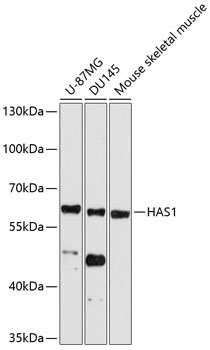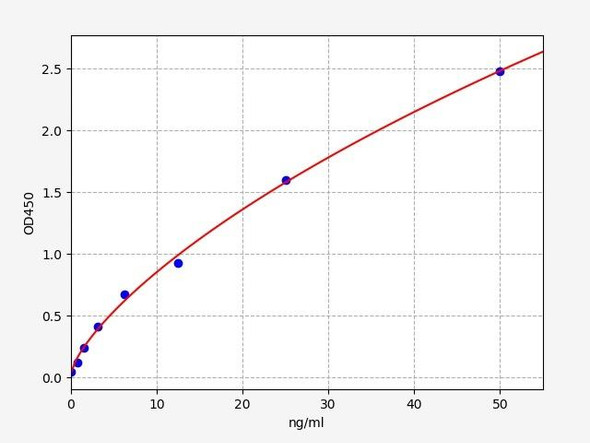Cell Biology Antibodies 1
Anti-HAS1 Antibody (CAB10453)
- SKU:
- CAB10453
- Product Type:
- Antibody
- Reactivity:
- Human
- Reactivity:
- Mouse
- Host Species:
- Rabbit
- Isotype:
- IgG
- Antibody Type:
- Polyclonal Antibody
- Research Area:
- Cell Biology
Description
| Antibody Name: | Anti-HAS1 Antibody |
| Antibody SKU: | CAB10453 |
| Antibody Size: | 20uL, 50uL, 100uL |
| Application: | WB |
| Reactivity: | Human, Mouse |
| Host Species: | Rabbit |
| Immunogen: | Recombinant fusion protein containing a sequence corresponding to amino acids 80-390 of human HAS1 (NP_001514.2). |
| Application: | WB |
| Recommended Dilution: | WB 1:500 - 1:2000 |
| Reactivity: | Human, Mouse |
| Positive Samples: | U-87MG, DU145, Mouse skeletal muscle |
| Immunogen: | Recombinant fusion protein containing a sequence corresponding to amino acids 80-390 of human HAS1 (NP_001514.2). |
| Purification Method: | Affinity purification |
| Storage Buffer: | Store at -20'C. Avoid freeze / thaw cycles. Buffer: PBS with 0.02% sodium azide, 50% glycerol, pH7.3. |
| Isotype: | IgG |
| Sequence: | RVAA AARG PLDA ATAR SVAL TISA YQED PAYL RQCL ASAR ALLY PRAR LRVL MVVD GNRA EDLY MVDM FREV FADE DPAT YVWD GNYH QPWE PAAA GAVG AGAY REVE AEDP GRLA VEAL VRTR RCVC VAQR WGGK REVM YTAF KALG DSVD YVQV CDSD TRLD PMAL LELV RVLD EDPR VGAV GGDV RILN PLDS WVSF LSSL RYWV AFNV ERAC QSYF HCVS CISG PLGL YRNN LLQQ FLEA WYNQ KFLG THCT FGDD RHLT NRML SMGY ATKY TSRS RCYS ETPS SFLR WLSQ QTRW SKSY FREW LYN |
| Gene ID: | 3036 |
| Uniprot: | Q92839 |
| Cellular Location: | Membrane, Multi-pass membrane protein |
| Calculated MW: | 64kDa |
| Observed MW: | 65kDa |
| Synonyms: | HAS1, HAS |
| Background: | Hyaluronan or hyaluronic acid (HA) is a high molecular weight unbranched polysaccharide synthesized by a wide variety of organisms from bacteria to mammals, and is a constituent of the extracellular matrix. It consists of alternating glucuronic acid and N-acetylglucosamine residues that are linked by beta-1-3 and beta-1-4 glycosidic bonds. HA is synthesized by membrane-bound synthase at the inner surface of the plasma membrane, and the chains are extruded through pore-like structures into the extracellular space. It serves a variety of functions, including space filling, lubrication of joints, and provision of a matrix through which cells can migrate. HA is actively produced during wound healing and tissue repair to provide a framework for ingrowth of blood vessels and fibroblasts. Changes in the serum concentration of HA are associated with inflammatory and degenerative arthropathies such as rheumatoid arthritis. In addition, the interaction of HA with the leukocyte receptor CD44 is important in tissue-specific homing by leukocytes, and overexpression of HA receptors has been correlated with tumor metastasis. HAS1 is a member of the newly identified vertebrate gene family encoding putative hyaluronan synthases, and its amino acid sequence shows significant homology to the hasA gene product of Streptococcus pyogenes, a glycosaminoglycan synthetase (DG42) from Xenopus laevis, and a recently described murine hyaluronan synthase. Alternative splicing results in multiple transcript variants. |
| UniProt Protein Function: | HAS1: Plays a role in hyaluronan/hyaluronic acid (HA) synthesis. Also able to catalyze the synthesis of chito- oligosaccharide depending on the substrate. Belongs to the NodC/HAS family. |
| UniProt Protein Details: | Protein type:Cell adhesion; EC 2.4.1.212; Membrane protein, integral; Membrane protein, multi-pass; Motility/polarity/chemotaxis; Transferase Chromosomal Location of Human Ortholog: 19q13.41 Cellular Component: integral to plasma membrane; plasma membrane Molecular Function:hyaluronan synthase activity Biological Process: cell adhesion; extracellular polysaccharide biosynthetic process; glycosaminoglycan biosynthetic process; hyaluronan biosynthetic process |
| NCBI Summary: | Hyaluronan or hyaluronic acid (HA) is a high molecular weight unbranched polysaccharide synthesized by a wide variety of organisms from bacteria to mammals, and is a constituent of the extracellular matrix. It consists of alternating glucuronic acid and N-acetylglucosamine residues that are linked by beta-1-3 and beta-1-4 glycosidic bonds. HA is synthesized by membrane-bound synthase at the inner surface of the plasma membrane, and the chains are extruded through pore-like structures into the extracellular space. It serves a variety of functions, including space filling, lubrication of joints, and provision of a matrix through which cells can migrate. HA is actively produced during wound healing and tissue repair to provide a framework for ingrowth of blood vessels and fibroblasts. Changes in the serum concentration of HA are associated with inflammatory and degenerative arthropathies such as rheumatoid arthritis. In addition, the interaction of HA with the leukocyte receptor CD44 is important in tissue-specific homing by leukocytes, and overexpression of HA receptors has been correlated with tumor metastasis. HAS1 is a member of the newly identified vertebrate gene family encoding putative hyaluronan synthases, and its amino acid sequence shows significant homology to the hasA gene product of Streptococcus pyogenes, a glycosaminoglycan synthetase (DG42) from Xenopus laevis, and a recently described murine hyaluronan synthase. Alternative splicing results in multiple transcript variants. [provided by RefSeq, Jul 2014] |
| UniProt Code: | Q92839 |
| NCBI GenInfo Identifier: | 209572627 |
| NCBI Gene ID: | 3036 |
| NCBI Accession: | Q92839.2 |
| UniProt Secondary Accession: | Q92839,Q14470, Q9NS49, |
| UniProt Related Accession: | Q92839 |
| Molecular Weight: | 65kDa |
| NCBI Full Name: | Hyaluronan synthase 1 |
| NCBI Synonym Full Names: | hyaluronan synthase 1 |
| NCBI Official Symbol: | HAS1 |
| NCBI Official Synonym Symbols: | HAS |
| NCBI Protein Information: | hyaluronan synthase 1 |
| UniProt Protein Name: | Hyaluronan synthase 1 |
| UniProt Synonym Protein Names: | Hyaluronate synthase 1; Hyaluronic acid synthase 1; HA synthase 1; HuHAS1 |
| Protein Family: | Hyaluronan synthase |
| UniProt Gene Name: | HAS1 |
View AllClose







